Nashville Opera
A Nightmare at the Opera – Britten’s Turn of the Screw
“A male figure introduces a curious story written in faded ink, in a woman’s hand” – a dry and concrete assertion begins the synopsis of Britten’s Turn of the Screw, one of the only grounding statements in this tale’s slow creep towards the nebulous and macabre. The Noah Liff Opera Center’s intimate thrusted stage provides a perfect setting for this chamber opera. close-packed audience can mark every horrified expression; performers have easy access from the stage for ghosts to waft out into the room and wail out of sight; utilitarian steel girders in the high ceiling require little imagination to perceive as murky church rafters or solid schoolhouse beams. Sparse decor in the form of dangling pure white figurines at various heights above the stage accompanies the minimal set pieces – a desk, bed, or few chairs are the entirety of furniture. Singers, instrumentalists, and lighting carry the show, easily enfolding the audience on this Friday night.
Scored for just 13 musicians, the prologue of the show opens with solely piano to provide a soundscape for the narrator, introducing Britten’s ever-shifting harmonic palette that flirts with serialism but never dives off the deep end. Some of the flourishes are reminiscent of Schoenberg’s writing in his 3 Klavierstücke, but beyond some rhythmic similarities their harmonic approaches to applying tone rows are vastly different. Michael Anderson’s “Prologue” establishes the setting with warmth and delicacy, giving away nothing of his dual role as Peter Quint later on.
The workout for the chamber orchestra takes many forms across the fifteen variations on the 12-tone row of the ‘Screw theme’, providing constant material to stitch together the scenes’ changes of locale and passage of time. From off-kilter rhythmic unisons, to every pairing of instruments to form every duet imaginable, or solos in staggered entrances and key areas – hearing the group put through their paces by Dean Williamson, conductor, covered the gamut from breathtakingly kinetic to serenely meditative. A treat, in this setting, to be so close to the instruments and be able to feel the low end from the piano, strings, and woodwinds, negating the proximity effect that frequently robs audiences in larger spaces the physical impact lower frequencies provide.

As each character is introduced we hear their talents both soloistically and in small groups, and with voices this skillful it is hard to say which context is preferable. Lara Secord-Haid as The Governess held such consistency
of tone while navigating leaps and bounds through the phrases built on the underlying serial concept, while Kaylee Nichols’s voice as Mrs. Grose filled the small theatre to overflowing with sound and clear diction. Their duets during Act I Scene 2: “The Welcome”, as The Governess first arrives and meets the children, and Act I Scene 3: “The Letter” when Miles is dismissed from school, combine the sounds to be an even more soaring sum of its parts, expounding on fondness for the children and the hopeful attitude of The Governess for an enjoyable post at the house.
No less of a surprisingly excellent match of blend and timbre are the voices of Caleb Killingsworth as Miles, and Helen Zhibing Huang as Flora. From their first entrance, their actions often ranged in tandem, initially from mere childish antics at school through to the mockery of hymns and the horrors of possession. It is vital that these characters mesh well in sound and behavior – Huang and Killingsworth are more than up to the task. Tom Tom the Piper’s Song was a particular marvel of a duet, shifting the melody ever higher into the stratosphere with apparently effortless ease. While neither are children (Killingsworth a counter-tenor junior studying at Nashville’s own Belmont University, Huang recently finishing a Young Artist Residency at Portland Opera), wonderful singing and convincing portrayals allow for forgiveness. Convincing 10-and-8 year olds to sing a 12-tone opera at 8 PM on a Friday would be a hard sell!

As an admitted John Wick stan, it was enjoyable to see a similar tactic of “tell don’t show” applied to the foul legacy of Peter Quint before his actual appearance. Muttered tales of his felonious behavior (“Quint was free with everyone… with little master Miles… he liked them pretty and he had his will, morning and night”) set up an impactful full entrance of the character after the first sightings. The explosion of sound emanating from Mrs. Grose, wailing “Dear God” when The Governess first describes the face of the ghost, is a memory that will remain in the brains of the audience for no short amount of time.
The pressure on Michael Anderson and Micaëla Aldrige to imbue their respective Peter Quint and Miss Jessel roles with a commanding amount of effective creepiness is heightened through the first act until their proper appearances. After such a buildup of exposition and tantalizing glimpses of their characters at the edges of the theatre and in offstage sung lines, the audience was well-rewarded for their patience. Britten, so careful to hint at horror and skirt around the edges for so long, firmly lands in that territory near the end of act one and into act two with possessions, candles being snuffed, and creepy children’s tunes. One can only imagine what the audience felt going in blind to the premiere in 1954, supposing they hadn’t read the book. With the minimal set design and stage props, it was a treat to see the presence of some classic horror tropes as well in the form of a pig-head-on-a-stick being paraded around and twisted contorted poses by the possessed children for the entracte variation to begin Act II.
Peter Quint as portrayed by Michael Anderson is a slimy figure of deft manipulation and delicate control. Plaintive crooning of Miles’s name as he slowly lures the child to his sway is, well, haunting, while the stark lighting under the stage casts enigmatic craggy shadows to his face – the audience must rely on the emotion in the voice to perceive Quint’s desires more than physical expression. Noticeable at times with other characters as well, such as some of The Governess’s less defined reactions – with the audience so intimately close by it seems a lost opportunity to forego stronger facial expressions. In more energized moments however, such as Quint’s insistent queries regarding the letter in Act II, the motivations come through clear as day in the middle of this dark performance. Perhaps as a result of Britten’s own biases in writing the Quint character for Peter

Pears, the role of Miss Jessel is not quite as dynamic, although Micaëla Aldrige handles it well. Her duet in Act II with The Governess was a highlight, navigating the rubbing dissonances at times written a direct half step off from the orchestra, leaning into those moments and reveling in the effect with confidence.
Finally, mention must be made of the excellent lighting design throughout, courtesy of Barry Steele’s work. The stage itself consisted of milky translucent panels through which light was projected, resulting in stark edges and long shadows. Combined with the overhead banks and some amazing and varied textures could be created. The sense of motion created for The Governesses opening journey by train was a particular marvel, while scenes at the lake contained a wonderful rippling effect of muted greens and blues that felt naturalistic and organic rather than gimmicky. Scenes in night varied from warm dusky hues of purples to more grim whites to great effect, and easily aided in fleshing out the scenes’ minimal sets.
With a densely tragic journey packed into a two-hour production on a Friday night in January, the audience was left wrung out at the conclusion of the evening. Britten’s Turn of the Screw was a bold and evocative programming choice to start the new year and new decade of programming. Nashville opera will return in the spring with a production of Rigoletto in April at the Tennessee Performing Arts Center. “



